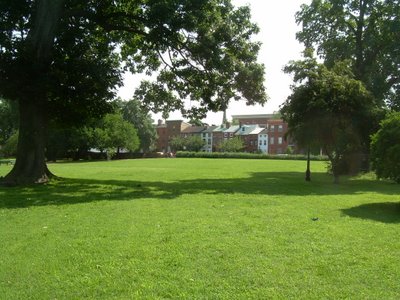WE INTERRUPT THIS STREET TO BRING YOU A ...ROUNDABOUT
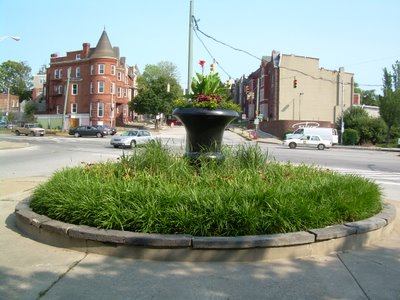
#1
North Avenue is not just a street. It's a state of mind. When you're on North Avenue, it's likely you won't forget where you're going. It's straight as an arrow across the entire urbanized city from Hilton to Milton, and it's 60 to 100 feet of pavement all the way.
Crossing North Avenue is also a memorable experience, especially at
Eutaw Place between Bolton Hill and Reservoir Hill. If North Avenue was not considered so significant, people wouldn't be willing to spend twice as much for the same house in Bolton Hill to the south as they do in Reservoir Hill to the north. If anything, the Victorian architecture in Reservoir Hill is even more extraordinary, yet many of its houses have been allowed to crumble to the ground. So it's the domination of a major east-west street, North Avenue, that makes its interruption of a north-south street,
Eutaw Place, so significant.
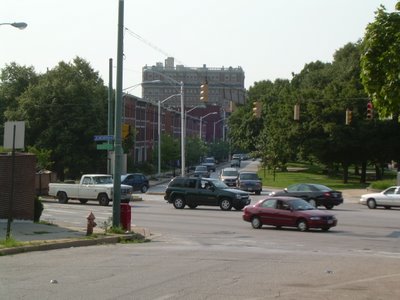
#2
But there's much more to it than that. South of North Avenue,
Eutaw Place has an elegant lush green median (see above and below). North of North Avenue, it does not. Back in the 1960s and 1970s, the City made a moat of demolition around Bolton Hill to seal it off from its surroundings. To the east, the east side of Mount Royal Avenue was torn up for the Jones Falls Expressway. To the south, most of Dolphin and Preston Streets were demolished to build the sterile State Office Complex. To the west, most of Linden Avenue was demolished.
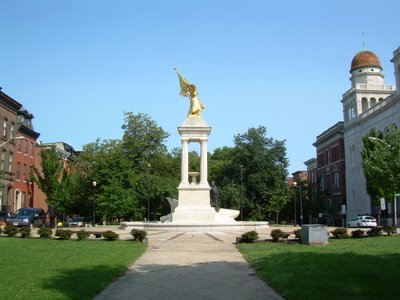
#3
Since Linden is east of
Eutaw Place, this actually placed
Eutaw with its classic green median outside of the protected area of Bolton Hill, but despite some terrible demolition decisions,
Eutaw was too beautiful to go down. The nine block segment of
Eutaw Place adjacent to Bolton Hill between Dolphin Street and North Avenue remains among America's most beautiful streets, comparable to Richmond's Monument Avenue or Boston's Commonwealth Avenue. The irreplaceable Francis Scott Key monument shown above is a highlight.
But
Eutaw Place was not enough to keep the Upton neighborhood west of Bolton Hill from going down, helped along by race riots and other factors such as a decision to inundate narrow
McCulloh Street and Druid Hill Avenue with heavy traffic.
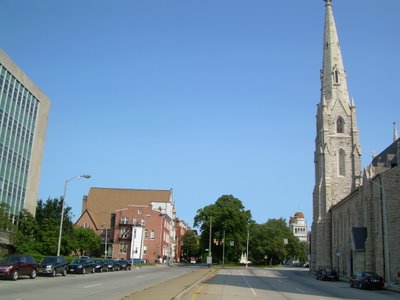
#4
The nine block stretch of
Eutaw Place with its classic green median remains an urban anomaly. South of Dolphin (see above), a four foot concrete median picks up where the monument studded urban masterpiece leaves off.

#5
But North Avenue has fared even worse. On the segment east of
Eutaw Place (see above), the street was widened from 60 to nearly 100 feet, to create room for left turn lanes and full-time parking lanes. Unfortunately, the village was destroyed in order to save it. In the widening effort, the buildings that could have taken advantage of the new parking and left turn access were demolished. The result is wide parking lanes with no one parking in them, a wide median with left turn lanes carved out of it, and traffic whizzing by on either side.
Urban designers know how to solve the void on North Avenue. The void is the lack of a "place". But who wants a place on North Avenue? When a new housing development was built in the southeast quadrant of North and
Eutaw a few years ago, the site plan scrupulously avoided orienting anything to North Avenue - providing just a fence to keep North Avenue out. The new housing has been highly successful but North Avenue still is not.
An urban design gesture in the right direction is illustrated at the top of this article (picture #1). Its a little landscaped circle with a diameter of about ten feet and a flower pot in the middle, located at the north end of the
Eutaw Place median. It probably looked appropriate on the construction drawings but it is very easy to ignore. North Avenue is a powerful state of mind so it will take a powerful sense of place to confront it.
The real answer for North Avenue at
Eutaw Place is just about the same thing, only much bigger - too big for anyone to ignore: The real answer is a roundabout - sometimes called a traffic circle.
Drivers tend to drive in a straight line unless provoked otherwise. Drivers travelling along North Avenue need to be forced to turn. A roundabout forces drivers to turn. A roundabout tells drivers: You are no longer on North Avenue. North Avenue temporarily does not exist. Your state of mind has been interrupted. You must react.
Once a driver turns into a roundabout, he or she enters a totally new frame of reference. The old reference of travelling east or west toward the rest of the city has been replaced by a reference only to the roundabout itself. There is only one direction to go - counterclockwise. The roundabout is utterly an abstraction because it will get you nowhere, except around in circles, and eventually back where you came from to be repeated again and again.
There is only one way out, and that is to let go of your
preconceived frame of reference and heed the rules of the roundabout instead. You must pay attention to where you are. You must read the signs and the environmental cues do what they tell you. There is no straight. There is no left. There is only a succession of right turns and you'd better figure out which is the correct one for you or you will travel in circles forever.
The roundabout rule is that drivers travelling around the circle always have the right of way, even though they don't want to go around it indefinitely. In a true roundabout, pedestrians are not allowed into the center circle, so they are not a factor in this.
Other than that, the rules for pedestrians are the same as for signalized intersections. Pedestrians always have the right of way over all turning traffic entering or exiting the roundabout, so it is critical that the roundabout be designed well so that pedestrians are able to invoke their power over turning traffic. This is the source of the roundabout's "traffic calming" effect.
Many drivers hate roundabouts. There is a disturbing lack of progress, a disturbing sense of infinity about them. Roundabouts require drivers to take
responsibility for their own actions, to make eye contact with their fellow drivers and pedestrians, and yet one must proceed in a direction that is not of one's own choosing. Of course, "hate" is a relative term. Many drivers hate North Avenue anyway. And when voting with their feet, most real estate buyers have had a lowly opinion of North Avenue for many years.
In a well designed roundabout, drivers are subservient to pedestrians, and all are subservient to the place itself. This is key. Drivers only have to go through the roundabout momentarily and then they are on their way. But the place itself is there 24/7/365. North Avenue is always where it has always been, even if only a shadow of its former self. People escape North Avenue but North Avenue cannot escape itself.
A roundabout is a place that must be recognized, confronted and reacted to. It is a place to put a statue or monument. It is a place to bridge the gaping gulf between Bolton Hill and Reservoir Hill.
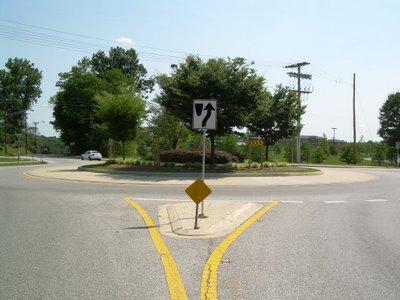
#6
The Maryland State Highway Administration has become quite adept at building roundabouts, such as the one shown here at
Wilkens Avenue and Hilltop Road adjacent to
UMBC. The formulas for determining the proper geometry of roundabouts and their approaches is quite exacting. This can tend to give a somewhat bland generic quality to roundabouts, but it doesn't have to.
The Baltimore region's roundabout in
extremis is located in downtown
Towson at the intersection of York,
Dulaney Valley, Allegheny and
Joppa Road. There have been many complaints about the
Towson roundabout, but anyone who remembers what this intersection was like before must admit that it is quite an improvement.
The
Towson roundabout is actually a victim of its own success. The huge amount of traffic it handles is a major
testament to its effectiveness, and yet it would work even better if it carried somewhat less traffic. Roundabouts can carry huge traffic volumes, but there are limits, and they are no substitute for good traffic management on the approach and bypass streets which
Towson sorely needs. But if a roundabout will work there, it will work on almost any urban intersection where space permits.
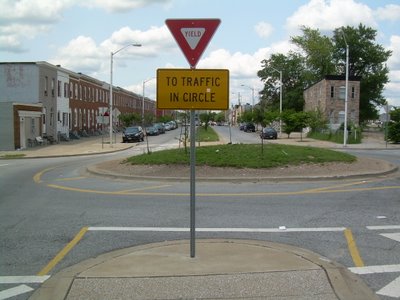
#7
Baltimore City has much less experience with roundabouts, and it shows. The one shown above is at
Wilkens Avenue at Mount Street. Trucks and even large cars routinely violate the striping and jump the curb into the circle, leaving tire tracks in the bare dirt. (And why do city street trees all seem to die so quickly?) Of course, space is usually at a premium in the City, but if there is not sufficient room for a well designed roundabout, then it shouldn't be built.
There are many good locations for roundabouts in Baltimore, and the intersection of North Avenue and
Eutaw Place is among the best. Imagine the intersection not as simply a place to be gotten though. Imagine the landscaped circle shown at the top of this article (picture #1) as something that is too big to ignore, right in the middle of the intersection where it must be recognized and confronted.
The intersection of
Eutaw Place and Dolphin Street, nine blocks south at the other end of the grand
Eutaw median (picture #4), would also be a great roundabout candidate.
Roundabouts are unique among traffic treatments in that they can handle very high traffic volumes, but can still calm the traffic in a way that makes it palatable to the adjacent communities. In this way, heavy traffic can be attracted to the streets which can best handle it rather than the streets with the least political clout.
In the vicinity of
Eutaw Place, it is
McCulloh Street and Druid Hill Avenue which have suffered from this fate of being the traffic dumping ground. While they are far narrower than
Eutaw Place, they carry more of the traffic burden, which tends to reverberate in the tight canyon between the closely spaced
rowhouses.
McCulloh and Druid Hill were
originally designed as small local streets, and were never intended to carry the traffic burden they have been forced to take on. Roundabouts on
Eutaw Place could be implemented in conjunction with changes to traffic patterns in Upton, Seton Hill and Druid Heights to encourage traffic to use
Eutaw Place instead of
McCulloh and Druid Hill, thus providing traffic relief to the entire area.
Of course, it's obvious that North Avenue has long been a dumping ground for heavy auto and truck traffic, and roundabouts would provide relief without reducing its ability to accommodate traffic instead of dumping it onto other nearby streets. As a tool for regulating traffic patterns, roundabouts can be used as both carrots and sticks.
In conjunction with the roundabout, West North Avenue should be narrowed back to approximately its original width or less. It should be no wider than necessary to serve any adjacent land uses and prevent bottlenecks from forming. The roundabout could then serve as a vital catalyst for reweaving the urban fabric that has long created scars between Bolton Hill and Reservoir Hill.
